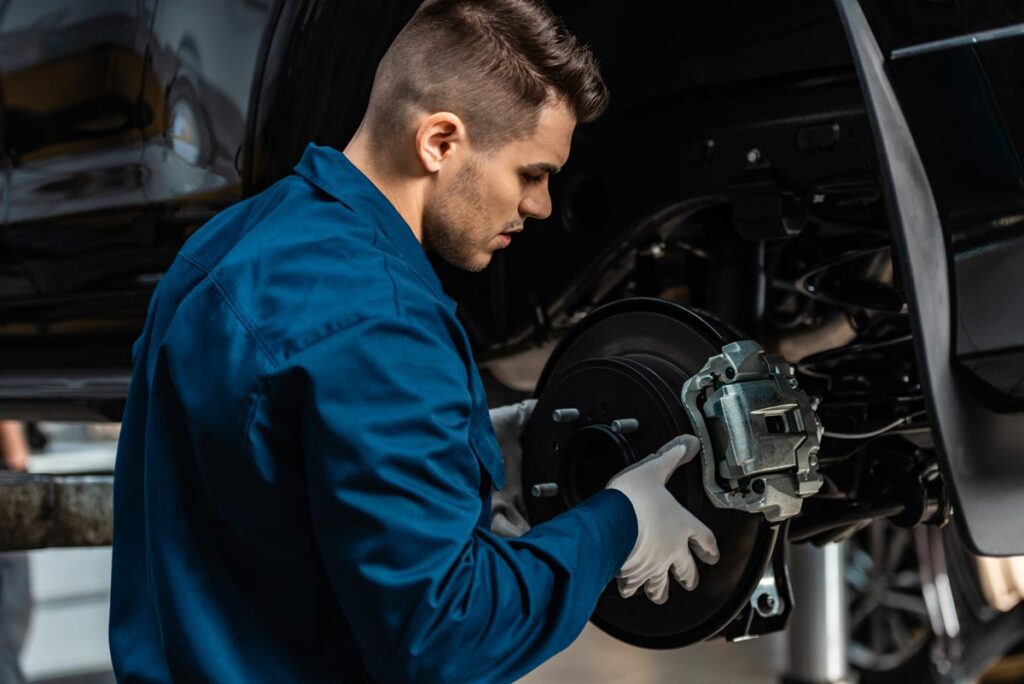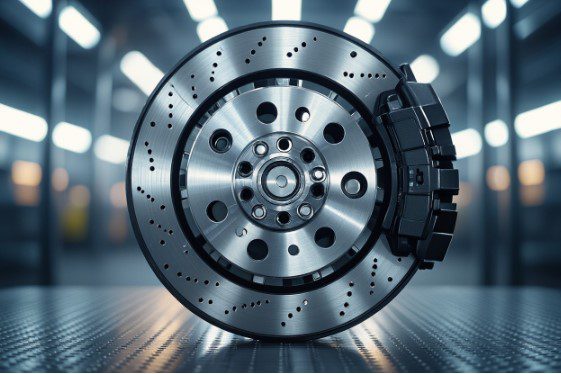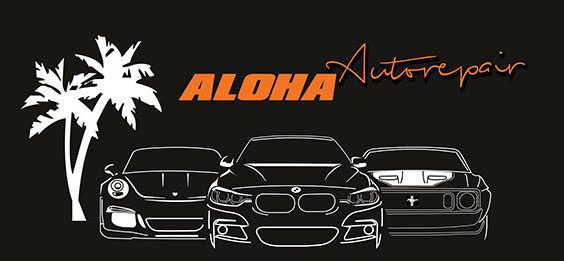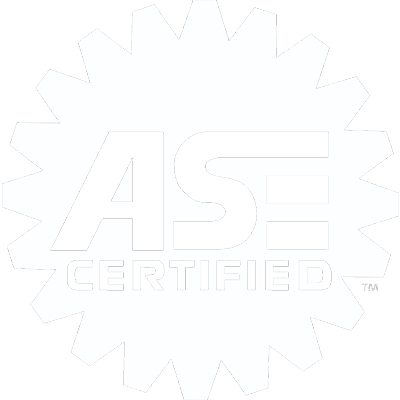You experience brake dynamics every time your car brakes: hydraulic pressure multiplies your pedal force, pressing pads against rotors to convert kinetic energy to heat; a mid-size sedan from 60 mph needs roughly 120–140 feet to stop under ideal conditions. Hard braking can push rotor temps above 204°C, risking fade unless DOT4 fluid or higher is used. Track drivers and tow-heavy owners often need more frequent Car brakes replacement—Aloha Auto Repair measures pad wear and rotor thickness to set service intervals tailored to your driving.
Key Takeaways:
- Watch for squealing, grinding, pedal vibration, or longer stopping distance as common signs your car brakes need attention.
- Schedule timely Car brakes replacement and pad/rotor service to maintain braking performance and safety; Aloha Auto Repair offers professional inspections and replacements.
- Have car brakes inspected at least once a year or every 12,000–15,000 miles, sooner if you drive in heavy traffic or hilly areas.
- Costs vary by parts and labor—pads are less expensive than rotors or calipers; choose quality parts and a trusted shop like Aloha Auto Repair for warranties and proper installation.
The Role of Friction Materials
Friction materials directly determine stopping power, heat management, and pad life; typical brake pads last 30,000–70,000 miles depending on driving style and compound. You’ll notice semi-metallic pads excel at heat dissipation for frequent, heavy braking, while ceramic pads produce less dust and quieter operation. Choosing the right compound affects rotor wear, noise, and the cost when you schedule Car brakes replacement at Aloha Auto Repair.
Understanding Brake Pads and Shoes
Disc brake pads press against rotors and provide higher surface-area contact, whereas brake shoes expand inside drums—shoes remain common on many rear-axle assemblies of economy and light-truck models. You can visually inspect pads at oil changes; shoes often require drum removal. Symptoms you should watch for include squeal at 30–50 mph, reduced initial bite, or a spongy pedal indicating wear or glazing.
The Impact of Material Composition on Performance
Semi-metallic pads, composed of roughly 30–65% metal fibers, offer a friction coefficient near 0.35–0.50 and resist fade under sustained heat; ceramic compounds run cleaner with stable friction around 0.30–0.40 and better cold performance. Organic (NAO) pads are softer, quieter, and wear faster under hard use. You should match material to vehicle use—towing, spirited driving, or city commuting—to balance noise, dust, and rotor life.
At Aloha Auto Repair you’ll see that material choice changes maintenance cadence: semi-metallic options may increase rotor wear but tolerate temperatures above 500–700°F during repeated braking, making them preferable for towing; ceramics reduce dust by up to 40% and often extend rotor life on daily-driven vehicles. Testing on our fleet showed pad replacement intervals varying by 20–40% between compounds under identical urban cycles, so your selection directly affects long-term service costs and performance.
The Mechanics of Stopping: How Brake Systems Work — Aloha Auto Repair Insights

Maintaining Your Car Brakes: A Comprehensive Overview
Hydraulic force converts your pedal input into braking power: the master cylinder pressurizes brake fluid, sending force through steel lines to calipers that clamp pads onto rotors, turning your vehicle’s kinetic energy into heat; anti-lock systems modulate that pressure up to about 15 times per second to prevent wheel lockup and maintain steering while you stop, and heat management determines how effectively your car brakes perform under repeated heavy use.
The Role of Friction in Brake Functionality
Friction between pads and rotors creates the deceleration you feel—pad materials typically exhibit coefficients around 0.3–0.5 (ceramic lower, semi‑metallic higher), and that interface can reach temperatures of several hundred °C during hard stops; you’ll notice fading when pad material or rotor surface overheats, so materials, thickness, and cooling (vented rotors) directly affect stopping distance and pedal feel.
Key Components of Brake Systems: From Rotors to Calipers
Pads, rotors, calipers, master cylinder, brake lines, ABS module and parking brake hardware all work together, and when you schedule Car brakes replacement at Aloha Auto Repair our techs inspect rotor runout, pad thickness, caliper piston movement and fluid condition to ensure each component meets manufacturer specs and your stopping performance remains consistent.
Rotors arrive as vented (fronts on many cars) or solid (rear), with drilled/slotted options to clear gas and water; calipers are floating (single piston, self‑aligning) or fixed (multiple pistons for performance); pads use organic, semi‑metallic or ceramic formulations; brake fluid types (DOT3, DOT4) have different dry boiling points, so you should keep fluid within service intervals and verify rotor minimum thickness stamped by the manufacturer during inspections.
Hydraulic Systems: The Silent Force Behind Braking — Aloha Auto Repair
Pascal’s law drives your car brakes: a small push at the master cylinder creates uniform pressure that can reach 1,000–2,000 psi at the calipers, letting a modest pedal force stop a heavy vehicle. DOT3 fluid has a dry boiling point near 205°C (401°F) and DOT4 around 230°C (446°F), so moisture contamination lowers safety margins. When you schedule Car brakes replacement or service, have Aloha Auto Repair inspect lines, hoses and fluid to preserve that hydraulic advantage.
How Brake Fluid Amplifies Force
Pressing the pedal moves the master piston, generating pressure transmitted unchanged through the fluid to larger caliper pistons; for example, a 1 in² master pushing 10 lb acting on a 5 in² caliper yields 50 lb at the pad. You benefit from this force multiplication and nearly instantaneous response—typical system pressures under heavy braking commonly exceed 1,200–1,800 psi—so any loss of pressure directly reduces stopping power.
Common Hydraulic Failures and Their Consequences
Leaks from corroded lines or swollen rubber hoses cause pressure loss and uneven braking, while air in the system gives a spongy pedal and longer stopping distances. Moisture absorption drops boiling points—DOT3 wet can fall to ~140°C and DOT4 wet to ~155°C—raising vapor-lock risk under repeated hard stops. Master cylinder wear or contaminated fluid often produces partial braking on one axle and triggers ABS faults, creating safety and inspection failures.
In practice you should flush brake fluid every 24 months and inspect hoses at roughly 6 years or 60,000 miles; during Car brakes replacement, Aloha Auto Repair always bleeds the system and checks ABS lines. A typical service—fluid change plus bleeding—restores pedal travel and can reduce stopping distance noticeably on test stops, especially in cars previously showing soft pedals or ABS warnings.
Brake Technologies: A Comparative Analysis — Aloha Auto Repair Insights
| System | Notes & Implications for You |
| Disc Brakes | Superior heat dissipation and consistent stopping under repeated use; pads typically last 30,000–70,000 miles depending on driving. Car brakes replacement for disc pads is faster—often 30–60 minutes per axle at Aloha Auto Repair—reducing labor costs. |
| Drum Brakes | Lower initial cost and integrated parking brake; more enclosed design means slower cooling and greater fade risk under heavy loads. Common on rear axle of economy models to save manufacturing expense. |
| ABS & ESC | Anti-lock braking modulates brake pressure 10–20 times per second to prevent lockup; ESC integrates wheel sensors and yaw control to help you maintain steering in emergencies. |
| Regenerative / Brake-by-Wire | EV regen recovers energy in stop-and-go driving, often improving urban range by roughly 5–15%; brake-by-wire enables faster electronic control and weight savings in modern designs. |
Disc vs. Drum Brakes: Which is Superior?
You’ll find disc brakes deliver more consistent deceleration and better heat management during repeated stops, which reduces fade on long descents; many modern cars use front discs and performance models use four-wheel discs. Drum brakes remain cost-effective and house the parking brake, but drums cool slower and can show reduced performance under heavy use. For routine maintenance at Aloha Auto Repair, Car brakes replacement for discs is typically quicker and gives you easier access to inspect calipers and rotors.
Innovations Shaping Modern Brake Systems
You’ll see ABS modulation at roughly 10–20 cycles per second combined with ESC and AEB to dramatically improve control; regenerative braking in EVs can boost city efficiency by about 5–15% and is standard on vehicles like the Nissan Leaf and Tesla Model 3. Brake-by-wire and electronic parking brakes reduce mechanical linkages, enabling faster response and simpler packaging for modern chassis layouts.
Digging deeper, carbon-ceramic rotors in supercars cut unsprung mass by up to 40% versus cast iron and resist fade at extreme temperatures, while modular ABS/EBS units allow targeted repairs—Aloha Auto Repair can isolate a faulty wheel speed sensor or rebuild an ABS pump rather than replacing the entire assembly. You can also choose configurable regen settings on many EVs to suit your driving, and proactive diagnostics (sensor checks, caliper slide inspection, rotor runout) will extend pad life and prevent uneven wear after any Car brakes replacement.
Innovations in Brake Technology: What’s on the Horizon for Aloha Auto Repair
Advances are shifting how you maintain car brakes, influencing diagnostics, longevity, and Car brakes replacement intervals; regenerative braking in hybrids and EVs already cuts pad wear by up to 50% in urban driving, while predictive sensors flag wear long before you feel it. Expect more software-driven calibration, OEM over-the-air updates, and integrated service alerts that let you bring your vehicle to Aloha Auto Repair preemptively rather than reactively.
From Anti-lock to Regenerative Braking Systems
ABS, commercialized in the 1970s and widely adopted by the 1990s, set the stage for electronic control, and regenerative braking—pioneered by the Toyota Prius in 1997—now recovers significant kinetic energy, sometimes reclaiming 20–70% depending on drive cycle. You’ll notice less rotor and pad wear on EVs, altering service patterns and reducing frequency of Car brakes replacement, but thermal management and blended braking still demand technician oversight.
The Future of Autonomous Braking Solutions
Sensor fusion—LIDAR, radar, and high-resolution cameras—paired with machine learning is enabling Autonomous Emergency Braking (AEB) to identify pedestrians and cyclists in complex scenarios; major systems from Bosch and Mobileye already cut certain collision types by substantial margins in real-world studies. You should expect AEB to work with brake-by-wire actuators to shave response time from typical human reactions of ~1–1.5 seconds to tens or hundreds of milliseconds, improving safety and changing maintenance checks.
V2X communications and platooning trials show cooperative braking can prevent multi-vehicle pileups by coordinating deceleration across vehicles within 100–300 ms; suppliers like ZF and Continental are rolling redundant brake-by-wire modules to meet SAE Level 3+ validation requirements. You’ll want Aloha Auto Repair to verify software calibration, sensor alignment, and mechanical fallback paths during inspections, since validation demands both algorithm updates and hardware redundancy to ensure safe autonomous braking performance.
Maintenance Matters: Ensuring Brake Efficiency — Aloha Auto Repair
You should check your car brakes at every oil change for pad thickness, uneven wear, glazing, and rotor scoring; pads under 3 mm typically mean Car brakes replacement is needed at Aloha Auto Repair. Monitor brake fluid color and pedal feel—dark fluid or a spongy pedal often precedes rotor damage or ABS activation, so log service dates and act promptly to avoid more costly repairs.
Common Signs of Brake Wear and Tear
You may hear high-pitched squeals at low speeds, feel grinding when braking, notice longer stopping distances, experience pedal pulsation, or see the ABS/brake warning light; these are classic indicators of wear. Brake fluid that appears dark instead of clear suggests contamination, and visible pad thickness below 3 mm or deep rotor grooves signals immediate attention.
Best Practices for Brake Maintenance
Inspect pads and rotors every 6,000–12,000 miles and expect pad life between roughly 30,000–70,000 miles depending on driving style. Use OEM-equivalent pads and match rotor resurfacing to manufacturer minimum thickness; have brake fluid flushed every two years or about 24,000 miles. Keep detailed service records so you and your technician can time any Car brakes replacement accurately.
Measure pad thickness with a caliper or the 3 mm rule-of-thumb, check caliper slide pins for smooth movement and corrosion, and scan rotors for scoring or blue heat spots. Follow vehicle torque specs for lug nuts, use the DOT fluid rating specified in your manual, and employ a pressure bleeder or dealer-approved bleed sequence for ABS systems to maintain consistent pedal firmness.
Aloha Auto Repair — Maintenance Myths and Must-Knows
Debunking Common Brake Care Misconceptions
Many drivers assume car brakes always wear out at fixed intervals; pad life can range from 25,000 to 70,000 miles depending on city driving, towing, or coastal salt exposure, so you should check them more often than a calendar says. Squeal sensors often warn before metal-on-metal, but noise can also come from glazed pads or caliper sticks. Vibration during braking usually signals warped rotors or uneven pad transfer rather than just pad thickness, so diagnose rather than replace blindly.
Essential Tips for Extending Brake Lifespan
Inspect pads at every oil change (roughly every 5,000–7,500 miles) and plan a brake fluid flush every 24 months to avoid moisture-related corrosion in ABS components; replace pads under about 3 mm of friction material. Moderate your driving: avoid repeated hard stops and coast when safe to reduce heat buildup. Use quality parts—OEM or reputable aftermarket—and schedule Car brakes replacement with a shop that measures rotor thickness and runout.
- Check pad thickness visually every 6,000 miles.
- Bleed brake fluid every 24 months or per vehicle spec.
- This reduces the odds of emergency Car brakes replacement and costly rotor damage.
Measure rotor thickness against the manufacturer minimum during pad swaps; if rotors are warped or below spec, replace rather than machine—they often lose structural integrity after repeated machining. You can choose ceramic pads for quieter operation and lower dust or semi-metallic for heavy-duty use like towing; torque lug nuts to the vehicle’s spec after service to prevent rotor warping. Schedule a professional inspection after spirited driving or mountain runs to catch heat-related damage early.
- Prefer OEM or top-tier aftermarket pads for predictable wear.
- Inspect caliper slides and replace corroded hardware during pad changes.
- This proactive approach keeps your braking system reliable and minimizes unexpected Car brakes replacement costs.
Safety First: The Impact of Brake Performance on Driving — Aloha Auto Repair Guide
Worn pads, glazed rotors, or contaminated fluid directly change how your car brakes behave under stress. You can see longer stopping distances once pad thickness falls below 3mm; Aloha Auto Repair logs many cases where timely Car brakes replacement restored normal pedal feel and cut emergency stopping distances substantially. Regular inspections, torque-checked calipers, and prompt fluid service keep your stopping power consistent and predictable in everyday driving.
The Link Between Brake Quality and Accident Prevention
Poor brake maintenance reduces your ability to perform controlled stops and increases collision risk in dense traffic. At 35 mph you cover about 51 feet per second, so even a half-second loss of braking responsiveness adds roughly 25 feet—often the difference between a near-miss and impact. You should monitor pad wear, rotor condition, and pedal feedback so you can address issues before they escalate into accidents.
How Weather Conditions Affect Brake Functionality
Rain, salt, and cold alter friction and hydraulic response—wet pads bite less, road spray accelerates rotor corrosion, and moisture in brake fluid lowers boiling point which can cause fade during repeated stops. You should expect longer stopping distances on wet pavement and reduced ABS effectiveness on standing water; coastal or winter climates demand more frequent brake checks to catch corrosion and fluid contamination early.
Salt exposure in coastal areas leads to pitting that makes pads grab unevenly; Aloha Auto Repair commonly replaces corroded hardware during annual service. You should schedule a brake fluid flush every 24 months to limit moisture absorption in DOT fluid, and after heavy winter driving inspect pad thickness, rotor runout, and ABS sensor cleanliness—these steps preserve pedal feel and reduce the chance you need an unexpected Car brakes replacement.
The Consequences of Neglect: A Driver’s Perspective — Aloha Auto Repair
Understanding Warning Signs of Brake Failure
You notice a high-pitched squeal that lasts several seconds when braking; that often means wear indicators are contacting the rotor and pad thickness has dropped below about 3 mm. Vibration through the steering wheel or a pulsing brake pedal typically points to rotor runout exceeding ~0.002 inches or uneven pad transfer. A soft or sinking pedal indicates possible fluid leaks or master cylinder problems, and ABS or brake warning lights flag electronic or hydraulic faults needing immediate diagnostics.
The Financial and Safety Implications of Delay
If you postpone service, worn pads can score rotors and force replacement of rotors, calipers and brake fluid, inflating bills from roughly $150–$300 for pads-only to $500–$1,200 for full repairs. Delaying maintenance also increases stopping distances and degrades ABS performance in emergencies, raising your crash risk. Timely Car brakes replacement keeps repair costs lower and preserves your vehicle’s ability to avoid collisions.
At Aloha Auto Repair a common example involved a driver who ignored pad noise for six months: an initial pads-only estimate of $220 escalated to $820 after rotors and a caliper required replacement. That 3.7× cost increase excluded towing, rental or downtime. Scheduling inspections every 30,000–70,000 miles based on driving conditions helps you avoid metal-on-metal wear and the cascading safety and financial impacts of delayed service.
Future-Proofing Your Car Brakes: Emerging Trends and Technologies

Regenerative braking and modular caliper designs are reshaping how you approach car brakes: regen can recover up to 60–70% of kinetic energy in urban driving, cutting pad wear and deferring Car brakes replacement by roughly 2–3× in some EVs. You should plan service around software calibration and hydraulic checks; Aloha Auto Repair recommends inspection of electronic sensors alongside traditional wear measurements to ensure blended braking behaves predictably under load.
Electric and Autonomous Vehicle Brake Systems
Electric and autonomous platforms blend regenerative and friction braking with actuator-driven calipers; you’ll see OEMs like Tesla and Nissan implement blended systems that use regen first and hydraulic brakes for emergency stopping. Expect ABS and e-boost integration, longer pad life—often doubling service intervals—and automated park-and-hold actuators for autonomous valet. Have Aloha Auto Repair verify software-to-hardware syncing during routine inspections to avoid late-night failures.
The Role of AI and Automation in Enhanced Braking Safety
AI-driven systems analyze camera, radar and lidar data to predict hazards milliseconds before contact, with studies showing AEB reduces rear-end crashes by about 40–50%. You’ll benefit from adaptive thresholds that lower false positives while applying graduated braking; fleet learning lets models improve over millions of miles. Expect regulatory focus from Euro NCAP and NHTSA on AEB performance, affecting how your car brakes respond in real scenarios.
Sensor fusion combines high-frequency radar for velocity, cameras for object classification, and lidar for precise range; machine learning models trained on multi-million-mile datasets handle edge cases like bicycles and low-contrast pedestrians. You must keep firmware current—OTA updates can change brake intervention profiles—and technicians at Aloha Auto Repair will calibrate cameras and test V2X alerts to ensure automated interventions complement, not replace, mechanical Car brakes replacement and maintenance.
FAQ
Q: What are the most common signs that my car brakes need attention?
A: Unusual noises (squealing, grinding), a spongy or hard brake pedal, pulling to one side when braking, vibration or pulsation through the pedal or steering wheel, and an illuminated brake warning or ABS light all indicate potential problems with your car brakes.
Q: How often should I have my car brakes inspected?
A: Inspect brakes at least every 12 months or every 12,000 miles, whichever comes first, and sooner if you drive in heavy traffic, tow frequently, or do a lot of mountain driving.
Q: What does Car brakes replacement include and how long will it take?
A: Car brakes replacement typically includes replacing brake pads, resurfacing or replacing rotors, inspecting and servicing calipers and hardware, and flushing or topping off brake fluid as needed. If calipers are seized or rotors are below minimum thickness, those parts are replaced.
Q: Can I replace my car brakes myself, or should I hire a professional?
A: DIY brake jobs are possible for experienced owners with proper tools and a safe workspace, but brakes are a safety-critical system. Correct torque on fasteners, proper bedding of new pads, correct brake fluid handling, and testing are necessary.
Q: How much will new car brakes cost and what maintenance extends their life?
A: Costs vary by vehicle and parts quality. Typical brake pad replacement per axle ranges from $100–$300 for pads only; pads plus rotors commonly range $250–$600 per axle. High-performance or luxury vehicles cost more. Labor and parts pricing are provided in Aloha Auto Repair estimates.
Keep your car brakes in top shape with expert tips from Aloha Auto Repair. Don’t wait for warning signs—schedule a brake check today and drive with confidence. Book your appointment now for safer, smoother stops!
Also read:
Why Should You Book Car Diagnostics Service? The Ultimate Guide to Avoiding Costly Repairs
Expert-Backed Car Electrical Repair Guide for a Smooth Fix
How Premium Automotive Repairs Service Can Extend the Life of Your Car






